三里岛事故调查报告
三里岛事故
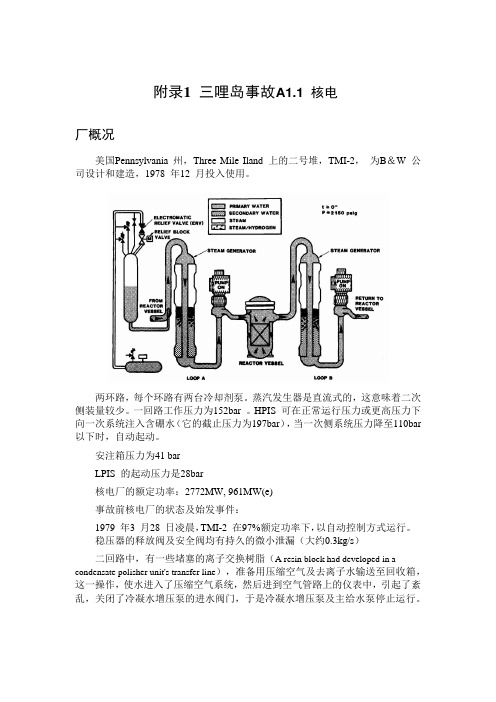
附录1 三哩岛事故A1.1 核电厂概况美国Pennsylvania 州,Three Mile Iland上的二号堆,TMI-2,为B&W 公司设计和建造,1978 年12 月投入使用。
两环路,每个环路有两台冷却剂泵。
蒸汽发生器是直流式的,这意味着二次侧装量较少。
一回路工作压力为152bar 。
HPIS 可在正常运行压力或更高压力下向一次系统注入含硼水(它的截止压力为197bar),当一次侧系统压力降至110bar 以下时,自动起动。
安注箱压力为41 barLPIS 的起动压力是28bar核电厂的额定功率:2772MW, 961MW(e)事故前核电厂的状态及始发事件:1979 年3 月28 日凌晨,TMI-2 在97%额定功率下,以自动控制方式运行。
稳压器的释放阀及安全阀均有持久的微小泄漏(大约0.3kg/s)二回路中,有一些堵塞的离子交换树脂(A resin block had developed in a condensate polisher unit's transfer line),准备用压缩空气及去离子水输送至回收箱,这一操作,使水进入了压缩空气系统,然后进到空气管路上的仪表中,引起了紊乱,关闭了冷凝水增压泵的进水阀门,于是冷凝水增压泵及主给水泵停止运行。
A1.2 事故过程A1.2.1 第一阶段汽轮机停车(0—6min)0 s汽轮机停车,蒸汽旁路阀打开,辅助给水泵启动,失去主给水,使蒸汽发生器从一回路系统导出热量减少,汽轮机停车后,主泵继续运行,反应堆继续运行。
反应堆冷却剂系统压力上升3—6 sRCS 压力达到PORV 整定值155bar,阀开启卸压,这不足以降压,RCS 压力继续上升8 sRCS 压力达到停堆整定值162 bar,控制棒插入堆芯,停堆,至此一切保护系统工作正常,接下来需要的是带走衰变热。
13 sRCS 压力降至PORV 自动关闭压力152bar,但关闭失效,卡开,造成了一个小破口失水事故(汽腔小破口),RCS 冷却剂不断从PORV 流失,在二回路系统中,全部三个辅助给水泵在运转,但是在SG 中水位在下降。
三里岛典型案例分析及整改措施流程详解

三里岛典型案例分析及整改措施流程详解下载温馨提示:该文档是我店铺精心编制而成,希望大家下载以后,能够帮助大家解决实际的问题。
文档下载后可定制随意修改,请根据实际需要进行相应的调整和使用,谢谢!并且,本店铺为大家提供各种各样类型的实用资料,如教育随笔、日记赏析、句子摘抄、古诗大全、经典美文、话题作文、工作总结、词语解析、文案摘录、其他资料等等,如想了解不同资料格式和写法,敬请关注!Download tips: This document is carefully compiled by theeditor.I hope that after you download them,they can help yousolve practical problems. The document can be customized andmodified after downloading,please adjust and use it according toactual needs, thank you!In addition, our shop provides you with various types ofpractical materials,such as educational essays, diaryappreciation,sentence excerpts,ancient poems,classic articles,topic composition,work summary,word parsing,copy excerpts,other materials and so on,want to know different data formats andwriting methods,please pay attention!三里岛核事故:典型案例分析与整改措施流程详解一、引言三里岛核事故,发生在1979年3月28日的美国宾夕法尼亚州,是商业核电历史上最严重的事故之一。
三里岛核电站事故视频文本资料记录

三里岛核电站事故视频文本资料记录美国三里岛压水堆核电厂二号堆于1979年3月28日发生的堆芯失水而熔化和放射性物质外逸的重大事故。
这次事故是由于二回路的水泵发生故障后,二回路的事故冷却系统自动投入,但因前些天工人检修后未将事故冷却系统的阀门打开,致使这一系统自动投入后,二回路的水仍断流。
当堆内温度和压力在此情况下升高后,反应堆就自动停堆,卸压阀也自动打开,放出堆芯内的部分汽水混合物。
同时,当反应堆内压力下降至正常时,卸压阀由于故障未能自动回座,使堆芯冷却剂继续外流,压力降至正常值以下,于是应急堆芯冷却系统自动投入,但操作人员未判明卸压阀没有回座,反而关闭了应急堆芯冷却系统,停止了向堆芯内注水。
这一系列的管理和操作上的失误与设备上的故障交织在一起,使一次小的故障急剧扩大,造成堆芯熔化的严重事故。
在这次事故中,主要的工程安全设施都自动投入,同时由于反应堆有几道安全屏障(燃料包壳,一回路压力边界和安全壳等),因而无一伤亡,在事故现场,只有3人受到了略高于半年的容许剂量的照射。
1979年3月28日,凌晨四点。
水管爆裂,阀门被打开,以释放反应堆内部的压力,但操作人员不知道阀门失灵,未能关闭,导致冷却水从阀门外流,堆芯温度过高。
技术故障之后又是认为失误,由于度数相左令人不解,操作员错误关闭了本可冷却堆芯的紧急供水系统,如果不是操作员干扰三里岛运作,关闭水泵,核电站本可自救。
当时所有人都认为考虑得很周全,却唯独没有考虑到操作人员的干扰后果,操作人员以为切断水阀是在挽救核电站,可实际上是他们亲手断送的。
数分钟内,控制室操作台陷入一片混乱,上百盏指示灯闪烁不停,警报声。
操作员不能逐个应付,只能按照轻重缓急优先处理。
太多数据一下涌入电脑,电脑进程太缓慢,来不及分析打印数据,报告得一个半小时才出来。
操作员始终坚信堆芯防护严密,安全无错,大多数人都在这干了半辈子,不相信会发生核灾难,他们的心态是拥有完备的安全系统。
控制室发现核辐射,报警。
F.美国三哩岛核电厂事件回顾案例讨论_简R1

背景與事件過程
1979 3 28 星期三4:00:37 AM
由於化學除污系統的樹脂發生阻 塞現象,使得凝結水幫浦跳脫, 進而也使飼水幫浦和汽機跳脫, 停止運轉。於是輔助幫浦自動啟 動,但由於輔助飼水管路上的一 閥門,在維修後沒有依照規定打 開,故無法將水注入蒸汽產生器 二次側,反應器內產生的熱無法 移除,造成反應器壓力快速上升 ,調壓槽灑水系統自動啟動灑水 降壓,釋壓閥亦開啟洩壓,但系 統壓力仍繼續上升,觸及反應器 急停設定值。控制棒插入爐心, 核分裂反應停止。
设施?技术支持中心tsc?在厂的作业支持中心osc?邻近厂区之紧急应变中枢eof?控制室的紧急反应功能数据系统?安全数据显示系统spds?核能数据链路ndlnureg0696要求核電廠?技術支援中心tsc?在廠的作業支援中心osceof?控制室的緊急反應功能?安全數據顯示系統spds?核能資料連結ndl运转员之要求
背景與事件過程
1979 3 28星期三6:18 AM 運轉人員此時終於注意到釋壓閥沒有 關閉,於是手動關閉了釋壓閥,反應器 溫度及壓力隨即上升。 1979 3 28星期三6:55 AM 由於燃料已有破損,冷卻系統之高放 射性警報響起。可惜沒有任何一位運轉 員聽到警笛聲。可能是由於數以百計的 警報聲響起,運轉員無法及時分辨處理 ,故隨手把警報關掉。也可能主要警報 聲響失效或是運轉員漏聽。此時,運轉 員依然不知道圍阻體建築內,含有放射 性的水和蒸汽量正持續的升高中。 1979 3 28星期三7:30 AM 圍阻體、反應器廠房和輔助廠房輻射 強度繼續上升。
背景与事件过程
1979 3 28星期三4:00:50 AM
反应器急停后,功率降低,反应 器压力亦随之降低。当反应器压力 降至释压阀门自动关闭点时,阀门 却没有关闭,于是冷却水由阀门持 续流出。由于辅助饲水无法进入蒸 汽产生器,故蒸汽产生器内二次侧 的水已逐渐被烧干。另一方面,释 压阀的开启造成反应器压力持续下 降,导致紧急炉心冷却系统自动启 动,将高压硼水注入炉心。运转员 开始担心调压槽的水位过高会使调 压槽丧失调压功能。然运转员此时 不知道蒸汽产生器已经没有饲水, 且调压槽释压阀发生故障,没有关 闭。
680. 核安全事故的案例分析与教训总结

680. 核安全事故的案例分析与教训总结680、核安全事故的案例分析与教训总结在人类利用核能的历史进程中,核安全事故犹如一道道醒目的警示,提醒着我们核能利用的复杂性和潜在风险。
核安全事故不仅会对人类健康、环境造成巨大的破坏,还会引发社会恐慌和经济损失。
为了更好地预防和应对核安全事故,我们有必要对一些典型的案例进行深入分析,并从中总结出宝贵的教训。
一、三里岛核事故1979 年 3 月 28 日,美国宾夕法尼亚州三里岛核电站发生了核泄漏事故。
这是美国历史上最严重的核事故之一。
事故起因是一个设备故障导致反应堆冷却剂系统的压力升高,安全阀自动开启,但随后未能正常关闭,导致大量冷却剂泄漏。
操作人员在应对过程中出现了一系列误判和操作失误,最终导致堆芯部分熔毁。
这次事故虽然没有造成直接的人员死亡,但对周围居民的心理和健康产生了长期的影响。
大量居民被迫撤离,周边地区的环境受到放射性污染。
从中我们得到的教训是:设备的可靠性和维护至关重要,操作人员的培训和应急响应能力需要不断加强。
同时,在事故发生后,及时、准确的信息公开对于缓解公众恐慌和稳定社会秩序起着关键作用。
二、切尔诺贝利核事故1986 年 4 月 26 日,苏联乌克兰境内的切尔诺贝利核电站发生了迄今为止世界上最严重的核事故。
事故的直接原因是在进行一项安全测试时,反应堆功率急剧上升,操作人员违规操作,导致反应堆失控爆炸。
大量放射性物质泄漏到大气中,随风飘散,对周边地区乃至整个欧洲的环境和居民健康造成了极其严重的影响。
这场灾难导致了大量人员的急性辐射病和死亡,许多人被迫离开家园。
受污染的地区在未来几十年内都无法正常居住和耕种。
切尔诺贝利核事故给我们的教训极其深刻。
首先,安全制度和操作规范必须严格遵守,任何违规行为都可能带来灾难性后果。
其次,对于核设施的设计和建设,必须充分考虑各种可能的风险,并采取有效的防护措施。
此外,国际社会在应对此类重大核事故时,需要加强合作,共同应对挑战。
三里岛核事故分析

03:13 :因担心水位继续上升会造成稳压器水实体运行,操纵员关闭一台HPI泵,安注流量从2.7m3/min下降至0.1m3/min。
三里岛事故演变
01
13:00 :四台主泵持续振动,且主泵电流低;由于回路B的两台主泵振动最大,操纵员停止了这两台泵的运行;
三里岛核事故
汇报日期
汇报人姓名
单/击/此/处/添/加/副/标/题/内/容
三里岛事故后果及反思
三里岛事故演变
三里岛事故概述
三里岛电厂系统简介
3
2
1
4
目录
1979年,在美国宾夕法尼亚州-哈里斯堡三里岛核电站,发生了美国核电史上最严重的核事故
包壳:Zr-4
05
专设安全设施:反应堆控制棒,高压注入应急堆芯冷却系统,含硼水箱,安全壳ECCS再循环水坑
给水系统:
三里岛电厂系统简介
三里岛事故概述
主给水系统失去运行,汽轮机停机 辅助给水系统未能投入运行; 稳压器泄压阀自动开启,反应堆停堆; 稳压器泄压阀未能关闭,失水事故; 高压安注系统自动动作,但注射流量被认为限制; 稳压器失去控制功能,堆腔上部形成蒸汽; 由于所有主泵停止运行,泄压阀不能关闭,堆芯失去了所有有效的冷却手段,堆芯过热,锆水反应,堆芯熔化。
2号机组以97%FP功率运行;
三位工作人员在维修精华给水系统的离子交换系统,忙于把7号凝结水净化箱内的树脂输送到树脂再生箱去;
在冲洗树脂时,水通过一个因故障卡开的逆止阀进入仪用压空系统,导致所有正在运行的的混床同时隔离;
凝结水流量丧失立即引起凝泵、凝升泵、主给水泵跳泵;导致给水总量丧失,汽机跳闸停机,ICS系统降反应堆功率;
三里岛核事故的结果是什么
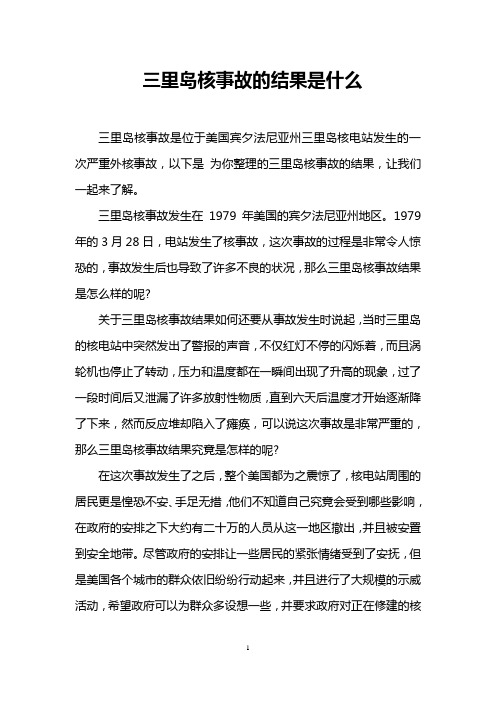
三里岛核事故的结果是什么三里岛核事故是位于美国宾夕法尼亚州三里岛核电站发生的一次严重外核事故,以下是为你整理的三里岛核事故的结果,让我们一起来了解。
三里岛核事故发生在1979年美国的宾夕法尼亚州地区。
1979年的3月28日,电站发生了核事故,这次事故的过程是非常令人惊恐的,事故发生后也导致了许多不良的状况,那么三里岛核事故结果是怎么样的呢?关于三里岛核事故结果如何还要从事故发生时说起,当时三里岛的核电站中突然发出了警报的声音,不仅红灯不停的闪烁着,而且涡轮机也停止了转动,压力和温度都在一瞬间出现了升高的现象,过了一段时间后又泄漏了许多放射性物质,直到六天后温度才开始逐渐降了下来,然而反应堆却陷入了瘫痪,可以说这次事故是非常严重的,那么三里岛核事故结果究竟是怎样的呢?在这次事故发生了之后,整个美国都为之震惊了,核电站周围的居民更是惶恐不安、手足无措,他们不知道自己究竟会受到哪些影响,在政府的安排之下大约有二十万的人员从这一地区撤出,并且被安置到安全地带。
尽管政府的安排让一些居民的紧张情绪受到了安抚,但是美国各个城市的群众依旧纷纷行动起来,并且进行了大规模的示威活动,希望政府可以为群众多设想一些,并要求政府对正在修建的核电站予以停工,或者直接将核电站关闭,他们的行动在当时造成了很大的影响,而美国以及西欧地区的国家不得不重新看待核动力的相关计划。
三里岛核事故的起因三里岛核电站是压水反应堆结构。
当时反应堆正在稳定地接近满功率运行,清晨4时,蒸汽发生器给水系统出了点毛病(一台把汽轮机冷凝水送回去的给水泵发生了故障)。
因此汽轮发电机自动脱扣了,控制棒插入反应堆。
反应堆功率下降,至此还没有发生什么事故。
三台备用给水泵本应供应必要的给水,可是它们没动,正如事后才搞清楚的,那是一个通往蒸汽发生器的阀门给错误地关闭了。
8分钟之后才发现这个错误,打开了阀门,但蒸汽发生器已经烧干了。
因此,一次水冷却剂温度和压力增加,顶开了稳压器上的安全阀。
美国三里岛核电站事故的调查报告
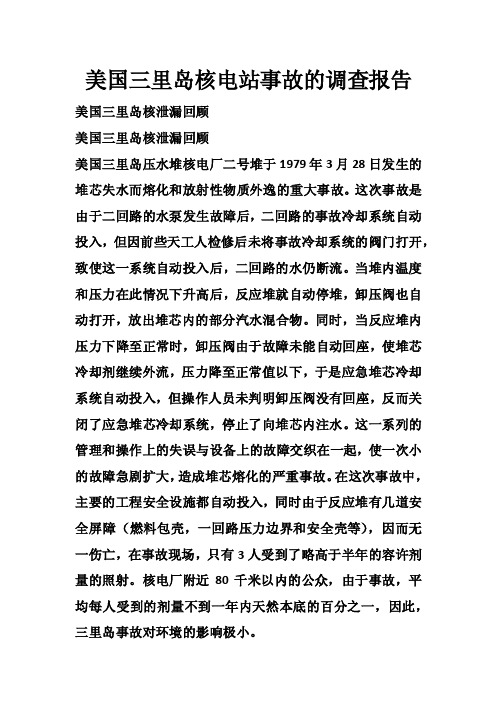
美国三里岛核电站事故的调查报告美国三里岛核泄漏回顾美国三里岛核泄漏回顾美国三里岛压水堆核电厂二号堆于1979年3月28日发生的堆芯失水而熔化和放射性物质外逸的重大事故。
这次事故是由于二回路的水泵发生故障后,二回路的事故冷却系统自动投入,但因前些天工人检修后未将事故冷却系统的阀门打开,致使这一系统自动投入后,二回路的水仍断流。
当堆内温度和压力在此情况下升高后,反应堆就自动停堆,卸压阀也自动打开,放出堆芯内的部分汽水混合物。
同时,当反应堆内压力下降至正常时,卸压阀由于故障未能自动回座,使堆芯冷却剂继续外流,压力降至正常值以下,于是应急堆芯冷却系统自动投入,但操作人员未判明卸压阀没有回座,反而关闭了应急堆芯冷却系统,停止了向堆芯内注水。
这一系列的管理和操作上的失误与设备上的故障交织在一起,使一次小的故障急剧扩大,造成堆芯熔化的严重事故。
在这次事故中,主要的工程安全设施都自动投入,同时由于反应堆有几道安全屏障(燃料包壳,一回路压力边界和安全壳等),因而无一伤亡,在事故现场,只有3人受到了略高于半年的容许剂量的照射。
核电厂附近80千米以内的公众,由于事故,平均每人受到的剂量不到一年内天然本底的百分之一,因此,三里岛事故对环境的影响极小。
三里岛压水堆核电站发生了堆芯熔毁的严重事故,然而,事故对环境和居民却没有造成任何危害和伤亡,也没有发现明显的放射性影响。
事实证明,压水堆核电站的各项安全设施是有效的。
检验结果表明在牛奶样品中基本上未查出放射性碘,其中最大的9个样品中碘-131浓度只有0.6—1.5贝可/升。
仅为允许值的千分之三。
电站下游两个不同地点采集的河水样品中没有查出任何放射性。
电站周围80公里范围内居民所受的剂量大约只是每年天然本底的1%左右;最大个人所受剂量,也只相当于一次X光医疗照射。
152个空气样品,只有8个样品发现微量放射性碘,而土壤样品均未查出放射性碘。
事故发生后,全美震惊,核电站附近的居民惊恐不安,约20万人撤出这一地区。
三里岛核事故分析

操作员在事故发生前曾违反了相关的操作规程,如未按规定进行定期检查和维护,增加了事故发生的可能性。
维护不足
长期缺乏维护和检修
三里岛核电站的设备长期缺乏必要的 维护和检修,导致设备老化、故障频 发,增加了事故风险。
未及时修复已知问题
电站管理层未能及时修复已知的安全 问题,如设备故障、老化等,这些问 题的存在增加了事故发生的可能性。
加强与其他国家的核技术交流与合 作,共同提高核安全水平。
联合应对
在核事故发生时,与其他国家共同 参与事故应对和救援行动,共同维 护地区核安全。
05
事故教训与启示
提高核设施安全标准
强化核设施设计
确保核设施在设计阶段就充分考虑到各种潜在风 险,提高设施的稳定性和可靠性。
定期安全审查
对核设施进行定期的安全审查,及时发现和解决 潜在的安全隐患,确保设施始终处于良好状态。
对表现优秀的操作人员进行奖励,对因操作失误导致的事故进行严 厉处罚,激励操作人员更加认真对待工作。
建立完善的核事故应急预案
1 2
制定应急预案
根据核设施的特点和潜在风险,制定完善的应急 预案,明确应急组织、救援措施和资源调配方案。
建立应急响应机制
建立高效的应急响应机制,确保在事故发生时能 够迅速启动应急预案,展开救援行动。
清理与去污
对事故现场进行彻底清理和去污,包括拆除受损设备、清理放射 性物质等。
修复与重建
对受损设施进行修复和重建,确保核电站安全稳定运行。
退役与最终处置
在核电站达到退役年限后,对核设施进行最终处置,确保永久安 全。
国际核事故合作
信息共享
及时向国际原子能机构和其他相 关国家通报事故情况,共享信息。
三里岛核事故分析

三里岛事故演变
• 04:00:03 :冷却剂系统压力上升,当压力达到 设定值15.5MPa,稳压器泄压阀PORV自动开启。 此时反应堆仍在满功率下运行; • 04:00:08 :反应堆自动停堆,冷却剂收缩、水 装量损失,一回路系统压力下降; • 04:00:13 :冷却剂从稳压器泄压阀处的持续泄 漏,以45m3/h的流量流失,蒸汽发生器水位 下降。 注:冷却剂收缩是由于蒸汽发生器的冷却能力超 过了堆芯释放出的160MW衰变热,冷却剂受到 冷却所致。
三里岛电厂系统简介
• 给水系统:
– 三台凝泵; – 一套含8台混床的凝结水全流量精处理装置; – 三台凝升泵; – 三台主给水泵(无除氧器); – 三台辅助给水泵(两台电动泵,一台汽动泵)。
三里岛事故概述
• • • • • 主给水系统失去运行,汽轮机停机 辅助给水系统未能投入运行; 稳压器泄压阀自动开启,反应堆停堆; 稳压器泄压阀未能关闭,失水事故; 高压安注系统自动动作,但注射流量被认为限 制; • 稳压器失去控制功能,堆腔上部形成蒸汽; • 由于所有主泵停止运行,泄压阀不能关闭,堆 芯失去了所有有效的冷却手段,堆芯过热,锆 水反应,堆芯熔化。
三里岛事故后果及反思
• 环境及周边影响:
– 约15居里的碘131,以及2*106居里的惰性气体 释放到环境;
– 由于反应堆有三道安全屏障,因而无一伤亡, 在事故现场,只有3人收到了略高于半年的允许 剂量的照射; – 核电厂附近80km以内的公众,由于事故,平均 每人受到的剂量不到一年内天然本底的百分之 一。因此,三里岛事故对环境的影响极小。
三里岛事故演变
• 04:01:13 :凝汽器热阱水位达到高报警值; 由于凝结水气动排水阀的仪用压空管线在 事故初始时已破裂,操纵员无法控制水位; • 04:02:02 :主系统压力下降至11.3MPa,专 设安全系统ESF触发;高压注入系统自动触 发向堆芯注入含硼水; • 04:03:13 :因担心水位继续上升会造成稳 压器水实体运行,操纵员关闭一台HPI泵, 安注流量从2.7m3/min下降至0.1m3/min。
三里岛核泄漏事故—5级

1979年三里岛核泄漏事故—5级在1979年3月28日,位于美国宾西法尼亚州的三里岛核电站的2号堆,发生了核电史上第一次严重事故。
这是由于水泵阀门信号灯故障和操作人员多次误操作所造成的。
反应堆堆芯两次露出水面,使燃料元件破坏和大约三分之二的堆芯熔化。
导致大量惰性气体和放射性碘与其他一些放射性核素进入了安全壳内。
并且由于锆包壳和水发生化学反应,也产生许多氢气,但没有发生爆炸。
因为安全壳的良好密封性和屏蔽作用,这次事故释放到环境中的放射性物质很少。
根据监测调查,对周围80千米的200万居民所带来的总剂量仅为20人·Sv(希沃特),不到这地区居民年本底辐射总剂量的(核设施建设运行之前该地区的辐射剂量水平)1%(这地区的年本底辐射总剂量2400人·Sv),附近居民受到的最大个人剂量不到1毫希沃特,只与作一次X光胸部透视所受的剂量差不多。
三里岛核电站值班的118名工作人员,无一伤亡,只有3人的受照剂量超过季度允许剂量水平。
在1979年之前,几乎很少有人听说过“三里岛”这个名字,但一场危机让这座位于美国宾夕法尼亚州东北部的核电站一下子闻名世界。
在那场持续一周的危机中,世界的目光被定格在哈里斯堡(宾夕法尼亚州首府),记者们喧嚷着拥入该地区,有人发誓说他看到辐射物像水珠一样从反应堆建筑物的一侧渗出、滴落……受史无前例的大地震影响,日本福岛核电站近日发生放射性物质外泄事件,引发各界对爆发一场核灾难的担忧。
实际上,自1954年世界上第一座核电站建成以来,类似的核危机曾不断上演,1957年的温德斯凯尔核电站事件,让核电持续几十年都是英国的“政治雷区”,1986年乌克兰切尔诺贝利核电站事故酿成的重大灾难则让世人“谈核色变”。
不过,有媒体评论称,这次日本爆发的核危机更像1979年美国“三里岛事件”的重演,那年三月,人类经历了核能发展史上第一起炉心熔毁事故,虽然没有造成任何人员伤亡,但美国人对核能安全性的认知深受影响,之后30余年,美国都没建起新的核电站。
The Three Mile Island Accident 美国三里岛事故解析
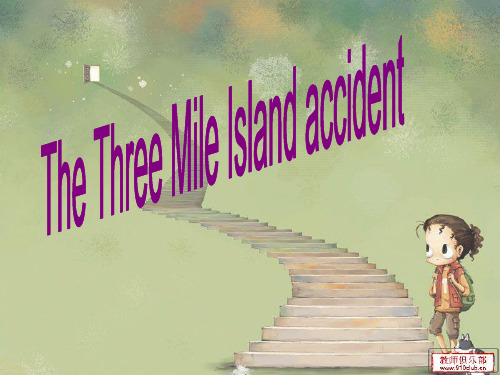
Unit 2 (二号反应堆)
Consequences of stuck valve Human factors – confusion over valve status
The design of the PORV(减压阀) indicator light was fundamentally flawed .And the operators had not been trained to use it. The operators did not correctly diagnose the problem Nuclear leak alarm did not attract the attention of operators
主水泵停转 辅助回路中 隔离阀门未打开
辅助水泵未正常开启 二号回路冷却水
蒸汽发生器
稳压器减压阀开启 一号回路冷却水流出
反应堆热量聚集 堆芯燃料元件烧毁
放射性物质泄漏
Schools were closed and residents were urged to stay indoors. pregnant women and preschool age children were emergency evacuation. Farmers were told to keep their animals under cover and on stored feed Cleanup started in August 1979 and officially ended in December 1993, with a total cleanup cost of about $1 billion
The power plant was owned and operated by General Public Utilities and Metropolitan Edison (Met Ed). The reactor involved in the accident, Unit 2, was a pressurized water reactor manufactured by Babcock & Wilcox.
三里岛汇报

5 6
06:30:00
反应堆厂房发生氢爆,
大量放射性物质进入
反应堆厂房和辅助厂
房。13个小时后,成
4
功实现强迫循环,事 故结束。
05:50:00
堆外探测器中子读数上 升约100倍,反应堆冷 却剂出口的过热蒸汽, 温度过高超过仪表量程
3
事故后果
严重后果
堆芯损毁
90%的核燃料的包壳损坏 锆水反应生成了1000到1300磅氢气,44%--63 %的锆氧化成氧
三里岛核电站系统简介
主冷却系统包含共两个环 路。每个环路两台主泵、一台 能产生过热蒸汽的直流式蒸汽 发生器。一台稳压器布置在其 中一个回路的热段,用于控制 主系统压力和补偿冷却剂的容 积变化。稳压器泄压阀在稳压 器达到15.5MPa时开启,将冷 却剂排放至稳压器泄压箱。
事件概述及核电站简介
三里岛核电站系统简介
正常运行时,主系统下泄流经过净 化进入容控箱,再经过一台上充泵 (共三台,正常工况时一台运行), 升压后作为上充流返回主系统。上 充流量通过一个气动阀调节,以控 制和维持稳压器的水位,保证主系 统的水装量。同时上充泵向4台主 泵提供轴封水。
一旦专设安全系统触发,在高压安 注阶段,主系统下泄自动隔离。两 台上充泵作为高压安注泵将换料水 箱的高硼水注入主系统。
官方消息的不准确以及夸大报道造成了民众的恐慌情绪。
4
经验和教训
经验和教训
安全屏障的重要性
三里岛事故之所以对环境造成的影响很小,其原因就是反应堆设 立的三道安全屏障(尤其是安全壳),安全屏障在事故发生堆芯裸露 及熔堆之后,很好的起到了CONTAIN(包容放射性产物)的作用。
旧核工业制度的改革
给水系统:
工作人员失误,导致三哩岛核电站泄露

一、从最初清洗设备的工作人员的过失开始,到反应堆彻底毁坏,整个过程只用了120秒1979年3月28日凌晨4时,美国宾夕法尼亚州的三哩岛核电站第2组反应堆的操作室里,红灯闪亮,汽笛报警,涡轮机停转,堆心压力和温度骤然升高。
2小时后,大量放射性物质溢出。
在三哩岛事件中,从最初清洗设备的工作人员的过失开始,到反应堆彻底毁坏,整个过程只用了120秒。
6天后,堆心温度开始下降,蒸气泡消失———引起氢爆炸的威胁解除了。
100吨铀燃料虽然没有熔化,但有60%的铀棒受到损坏,反应堆最终陷于瘫痪。
核事故共7个级别,级别越高,危害越大。
此事故为核事故的第五级。
事故发生后,全美震惊,核电站附近的居民惊恐不安,约20万人撤出这一地区。
美国各大城市的群众和正在修建核电站的地区的居民纷纷举行集会示威,要求停建或关闭核电站。
美国和西欧一些国家政府不得不重新检查发展核动力计划。
二、在这次事故中,主要的工程安全设施都自动投入,同时由于反应堆有几道安全屏障(燃料包壳,一回路压力边界和安全壳等),因而无一伤亡这次事故是由于二回路的水泵发生故障后,二回路的事故冷却系统自动投入,但因前些天工人检修后未将事故冷却系统的阀门打开,致使这一系统自动投入后,二回路的水仍断流。
当堆内温度和压力在此情况下升高后,反应堆就自动停堆,卸压阀也自动打开,放出堆芯内的部分汽水混合物。
同时,当反应堆内压力下降至正常时,卸压阀由于故障未能自动回座,使堆芯冷却剂继续外流,压力降至正常值以下,于是应急堆芯冷却系统自动投入,但操作人员未判明卸压阀没有回座,反而关闭了应急堆芯冷却系统,停止了向堆芯内注水。
这一系列的管理和操作上的失误,与设备上的故障交织在一起,使一次小的故障急剧扩大,造成堆芯熔化的严重事故。
在这次事故中,主要的工程安全设施都自动投入,同时由于反应堆有几道安全屏障(燃料包壳,一回路压力边界和安全壳等),因而无一伤亡。
在事故现场,只有3人受到了略高于半年的容许剂量的照射。
三里岛事故调查报告
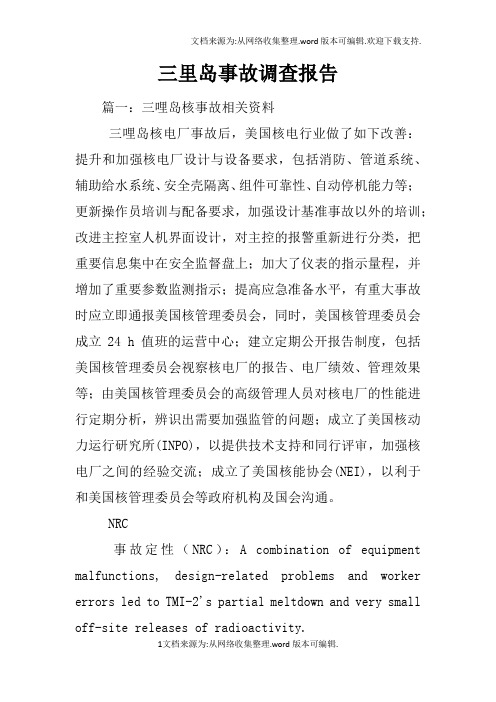
三里岛事故调查报告篇一:三哩岛核事故相关资料三哩岛核电厂事故后,美国核电行业做了如下改善:提升和加强核电厂设计与设备要求,包括消防、管道系统、辅助给水系统、安全壳隔离、组件可靠性、自动停机能力等;更新操作员培训与配备要求,加强设计基准事故以外的培训;改进主控室人机界面设计,对主控的报警重新进行分类,把重要信息集中在安全监督盘上;加大了仪表的指示量程,并增加了重要参数监测指示;提高应急准备水平,有重大事故时应立即通报美国核管理委员会,同时,美国核管理委员会成立24 h 值班的运营中心;建立定期公开报告制度,包括美国核管理委员会视察核电厂的报告、电厂绩效、管理效果等;由美国核管理委员会的高级管理人员对核电厂的性能进行定期分析,辨识出需要加强监管的问题;成立了美国核动力运行研究所(INPO),以提供技术支持和同行评审,加强核电厂之间的经验交流;成立了美国核能协会(NEI),以利于和美国核管理委员会等政府机构及国会沟通。
NRC事故定性(NRC):A combination of equipment malfunctions, design-related problems and worker errors led to TMI-2's partial meltdown and very small off-site releases of radioactivity.设备故障、设计缺陷以及人员失误一系列综合因素导致了三哩岛核电厂(TMI)2号机组部分堆芯熔毁,极少量放射性物质外泄。
1 Impact of the AccidentA combination of personnel error, design deficiencies, and component failures caused the Three Mile Island accident, which permanently changed both the nuclear industry and the NRC. Public fear and distrust increased, NRC's regulations and oversight became broader and more robust, and management of the plants was scrutinized more carefully. Careful analysis of the accident's events identified problems and led to permanent and sweeping changes in how NRC regulates its licensees – which, in turn, has reduced the risk to public health and safety.事故影响设备故障、设计缺陷以及人员失误一系列综合因素导致了三哩岛核事故的发生,永久改变了美国核工业与美国核管会(NRC)。
三里岛——操纵员的自述

事故背后的组织因素
处臵事故的方法: 事故规程的编写是以事件导向为基础的。 如果操纵员能够正确地识别故障,规程就 会提供正确地处臵方法。 所有的事故培训都要求操纵员能正确的识 别故障,然后正确地执行相关事故规程。 但是我们错误地识别了故障,采取了错误 的行动。
事故背后的组织因素
自动化的讽刺:
事故后的进步
设计改进: 改进主控报警系统;
改进主控室显示仪表的界面,以及采用数字 化仪表;
改进各系统控制盘台上的流程模拟图,阀门 和泵用不同的符号表示; 数据计算机更换为三台带多个终端的新型计 算机; 在主控室增加了一套工业电视系统,用于监 视重要安全设备的现场状况。
事故后的进步
事故背后的组织因素
规程针对大问题: 我们预期的大问题是大LOCA事故。事故进 程非常短,只有几分钟时间。 对每一个预期的事故,我们都有详细的处臵 规程。 针对大LOCA事故,有几种独立的注水系统 用于补偿冷却剂泄漏。 (续下页)
事故背后的组织因素
规程针对大问题: 电站设计者相信,只要这些系统按照设计 要求发挥作用,反应堆就不会毁坏。 但是他们错了,因为三哩岛事故出现的是 “小问题”——泄漏非常小。事故处理持 续了数天。
事故背后的组织因素
例外运行——思维模式
操纵员的心理(思维)模式拘泥于例外运行
例外运行的心理(思维)模式假定:系统设 备处于正常运行、正常发挥功能的状态,除 非仪表显示、报警、交接班信息提供了例外 信息——异常状况。
在这种思维模式下,交接班时重要信息(辅 助给水电动隔离阀关闭)的遗失导致了严重 后果。 注:安全文化倡导的“质疑的态度”可以避 免陷入这种思维模式。
建立电站状态报告系统。
三里岛事件和切尔诺贝利事故的真相
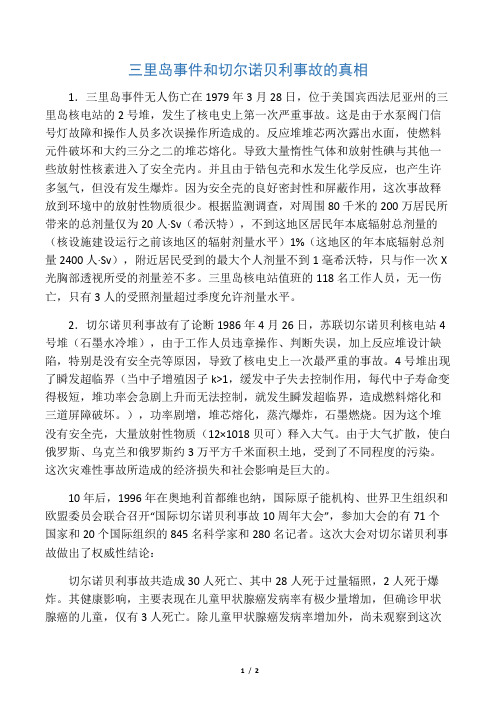
三里岛事件和切尔诺贝利事故的真相1.三里岛事件无人伤亡在1979年3月28日,位于美国宾西法尼亚州的三里岛核电站的2号堆,发生了核电史上第一次严重事故。
这是由于水泵阀门信号灯故障和操作人员多次误操作所造成的。
反应堆堆芯两次露出水面,使燃料元件破坏和大约三分之二的堆芯熔化。
导致大量惰性气体和放射性碘与其他一些放射性核素进入了安全壳内。
并且由于锆包壳和水发生化学反应,也产生许多氢气,但没有发生爆炸。
因为安全壳的良好密封性和屏蔽作用,这次事故释放到环境中的放射性物质很少。
根据监测调查,对周围80千米的200万居民所带来的总剂量仅为20人·Sv(希沃特),不到这地区居民年本底辐射总剂量的(核设施建设运行之前该地区的辐射剂量水平)1%(这地区的年本底辐射总剂量2400人·Sv),附近居民受到的最大个人剂量不到1毫希沃特,只与作一次X 光胸部透视所受的剂量差不多。
三里岛核电站值班的118名工作人员,无一伤亡,只有3人的受照剂量超过季度允许剂量水平。
2.切尔诺贝利事故有了论断1986年4月26日,苏联切尔诺贝利核电站4号堆(石墨水冷堆),由于工作人员违章操作、判断失误,加上反应堆设计缺陷,特别是没有安全壳等原因,导致了核电史上一次最严重的事故。
4号堆出现了瞬发超临界(当中子增殖因子k>1,缓发中子失去控制作用,每代中子寿命变得极短,堆功率会急剧上升而无法控制,就发生瞬发超临界,造成燃料熔化和三道屏障破坏。
),功率剧增,堆芯熔化,蒸汽爆炸,石墨燃烧。
因为这个堆没有安全壳,大量放射性物质(12×1018贝可)释入大气。
由于大气扩散,使白俄罗斯、乌克兰和俄罗斯约3万平方千米面积土地,受到了不同程度的污染。
这次灾难性事故所造成的经济损失和社会影响是巨大的。
10年后,1996年在奥地利首都维也纳,国际原子能机构、世界卫生组织和欧盟委员会联合召开“国际切尔诺贝利事故10周年大会”,参加大会的有71个国家和20个国际组织的845名科学家和280名记者。
(完整word版)切尔诺贝利核泄漏事故报告

切尔诺贝利核电站核泄露事故报告如果说1979年的美国三里岛核电站事故引起了美国舆论的哗然,那么,1986年4月26日前苏联切尔诺贝利核电站发生的事故,则震动了世界,其后果几乎影响到整个国际能源界。
这一天的凌晨1点23分,位于苏联大城市基辅以北130公里白俄罗斯-乌克兰大森林地带东部的切尔诺贝利核电站,第四号机组发生了事故,反应堆猛烈爆炸,引起熊熊大火导致反应堆堆芯毁坏和部分厂房倒塌。
这次事故是发生在该机组计划停堆检修,做一个透平发电机运行状态试验的过程中,反应堆出现突然的功率波动导致反应堆毁坏和堆芯积累的一部分放射性物质释放到大气中。
事故发生以后,引起的大火被扑灭,展开了限制和消除事故后果的紧张工作。
撤离了核电站毗邻地区及电站周围30公里地带的居民。
为此,苏共中央政治局成立了一个由苏联部长会议主席为首的工作组,以协调各部和其他国家机关消除事故后果及援助居民的工作。
还成立了一个政府工作委员会,着手调查事故的原因和执行必不可少的应急措施;从事恢复工作,其作用在能够动员全苏必要的科学、技术和经济方面的应变能力。
一项工业生产事故引起国家最高当局重视并亲手处理,这在苏联的历史上恐怕是少有的。
可见核科技在当代社会生活中的地位及对人们心理的影响。
他们动员了部队、地方及其他各产业部门的人力、物力和交通运输工具等,也动员人民献血和组织现场快速处理事故的志愿人员。
更重要的是,事故不只是影响到了核设施所在地区所在国家的利益,它越过了国界,波及到毗邻国家,引起了别国的慌乱,使那里的人民失去了安全感。
因此,与其说事故本身之大,还不如说是国际舆论惊动了苏联的整个领导层。
其实,在苏联及世界其他国家的能源工业生产中,一次事故所造成的伤亡和损失远大于这次切尔诺贝利核电站事故的有的是。
具有强烈讽刺意味的对比是,1979年美国三里岛核电站事故发生的同一天,印度一座水电站大坝开裂,造成成千上万人丧生,而三里岛事故中却无一人死亡。
可是印度的水电站事故并没有引发如此复杂的舆论和触动由低级到高级的各阶层人士。
- 1、下载文档前请自行甄别文档内容的完整性,平台不提供额外的编辑、内容补充、找答案等附加服务。
- 2、"仅部分预览"的文档,不可在线预览部分如存在完整性等问题,可反馈申请退款(可完整预览的文档不适用该条件!)。
- 3、如文档侵犯您的权益,请联系客服反馈,我们会尽快为您处理(人工客服工作时间:9:00-18:30)。
三里岛事故调查报告篇一:三哩岛核事故相关资料三哩岛核电厂事故后,美国核电行业做了如下改善:提升和加强核电厂设计与设备要求,包括消防、管道系统、辅助给水系统、安全壳隔离、组件可靠性、自动停机能力等;更新操作员培训与配备要求,加强设计基准事故以外的培训;改进主控室人机界面设计,对主控的报警重新进行分类,把重要信息集中在安全监督盘上;加大了仪表的指示量程,并增加了重要参数监测指示;提高应急准备水平,有重大事故时应立即通报美国核管理委员会,同时,美国核管理委员会成立24 h 值班的运营中心;建立定期公开报告制度,包括美国核管理委员会视察核电厂的报告、电厂绩效、管理效果等;由美国核管理委员会的高级管理人员对核电厂的性能进行定期分析,辨识出需要加强监管的问题;成立了美国核动力运行研究所(INPO),以提供技术支持和同行评审,加强核电厂之间的经验交流;成立了美国核能协会(NEI),以利于和美国核管理委员会等政府机构及国会沟通。
NRC事故定性(NRC):A combination of equipment malfunctions, design-related problems and worker errors led to TMI-2's partial meltdown and very small off-site releases of radioactivity.设备故障、设计缺陷以及人员失误一系列综合因素导致了三哩岛核电厂(TMI)2号机组部分堆芯熔毁,极少量放射性物质外泄。
1 Impact of the AccidentA combination of personnel error, design deficiencies, and component failures caused the Three Mile Island accident, which permanently changed both the nuclear industry and the NRC. Public fear and distrust increased, NRC's regulations and oversight became broader and more robust, and management of the plants was scrutinized more carefully. Careful analysis of the accident's events identified problems and led to permanent and sweeping changes in how NRC regulates its licensees – which, in turn, has reduced the risk to public health and safety.事故影响设备故障、设计缺陷以及人员失误一系列综合因素导致了三哩岛核事故的发生,永久改变了美国核工业与美国核管会(NRC)。
事故发生后,公众对核能的恐惧和不信任日益增长,NRC管理与监督范围更广,也更为严格。
NRC通过对三哩岛核事故进行仔细分析,对核电厂持证单位管理做出了彻底改进,降低了公众健康和安全风险。
事故后,NRC做出的部分主要变更如下:Here are some of the major changes that have occurred since the accident:?Upgrading and strengthening of plant design and equipment requirements. This includes fire protection, piping systems, auxiliary feedwater systems, containment building isolation, reliability of individual components (pressure relief valves and electrical circuit breakers), and the ability of plants to shut down automatically;完善核电厂设计与设备要求,包括消防、管道系统、辅助给水系统、安全壳厂房隔离、单一部件可靠性(泄压阀和电路断路器)以及反应堆自动停堆的能力。
?Identifying the critical role of human performance in plant safety led to revamping operator training and staffing requirements, followed by improved instrumentation and controls for operating the plant, and establishment of fitness-for-duty programs for plant workers to guard against alcohol or drug abuse;更新操纵员培训与配备要求,改进在运核电厂仪控系统,以及建立适勤制度,防止核电厂员工酗酒或滥用药物。
?Enhancing emergency preparedness, including requirements for plants to immediately notify NRC of significant events and an NRC Operations Center staffed 24 hours a day. Drills and response plans are now tested by licensees several times a year, and state and local agencies participate in drills with the Federal Emergency Management Agency and NRC;提高应急准备水平,有重大事故时应立即通报NRC,同时,NRC成立24小时值班的运营中心。
持证单位每年开展数次核电厂应急演练,当地机构与联邦应急管理署(FEMA)、NRC也需参与其中。
?Integrating NRC observations, findings, and conclusions about licenseeperformance and management effectiveness into a periodic, public report;建立定期公开报告制度,包括美NRC视察核电厂的报告、电厂绩效、管理效果等。
?Having senior NRC managers regularly analyze plant performance for those plants needing significant additional regulatory attention;NRC高级管理人员对需要额外加强监管的核电厂进行定期绩效分析;?Expanding NRC's resident inspector program –first authorized in 1977 –to have at least two inspectors live nearby and work exclusively at each plant in the to provide daily surveillance of licensee adherence to NRC regulations;NRC增加向所有核电厂派遣的驻厂人员,从1977年的一名检查员提高到至少2名,负责监督持证单位是否严格遵循NRC管理条例。
?Expanding performance-oriented as well as safety-oriented inspections, and the use of risk assessment to identify vulnerabilities of any plant to severe accidents;扩大绩效和啊暖检查,以及利用风险评估来确定核电厂在应对严重事故领域存在的缺陷;?Strengthening and reorganizing enforcement staff in a separate office within the NRC;对NRC执法人员进行重组,设立单独办公室;?Establishing the Institute of Nuclear Power Operations, the industry's own "policing" group, and formation of what is now the Nuclear Energy Institute to provide a unified industry approach to generic nuclear regulatory issues, and interaction with NRC andother government agencies;成立了美国核动力运行研究所(INPO),以提供技术支持和同行评审,加强核电厂之间的经验交流,以及成立了美国核能协会(NEI),以利于与NRC等政府机构及国会沟通。
?Installing additional equipment by licensees to mitigate accident conditions, and monitor radiation levels and plant status;持证单位在厂内安装额外设备,以有效缓解事故工况,监督辐射水平和运行情况;?Enacting programs by licensees for early identification of important safety-related problems, and for collecting and assessing relevant data so operating experience can be shared and quickly acted upon; and持证单位开展检查项目,以在早期发现重大安全问题,收集并评估相关数据,从而可积累运行经验以及及时采取行动;?Expanding NRC's international activities to share enhanced knowledge of nuclear safety with other countries in a number of important technical areas.NRC加强国际交流合作,与其他国家共享核安全经验。
